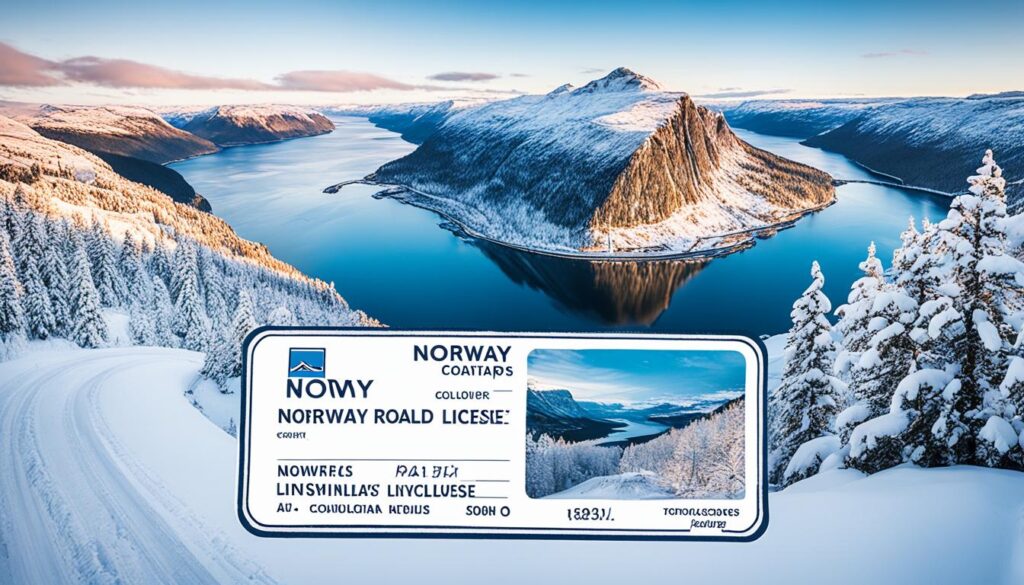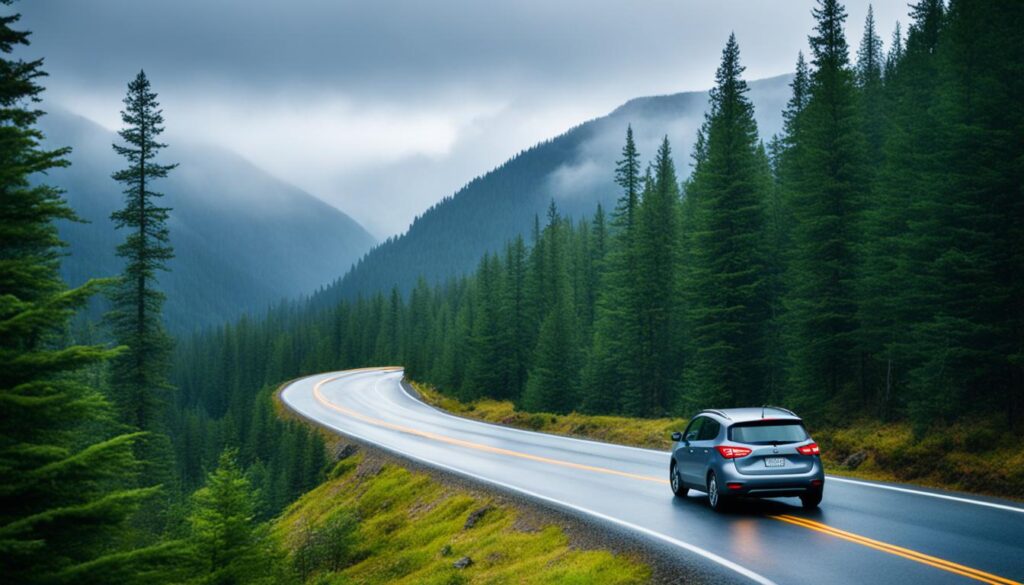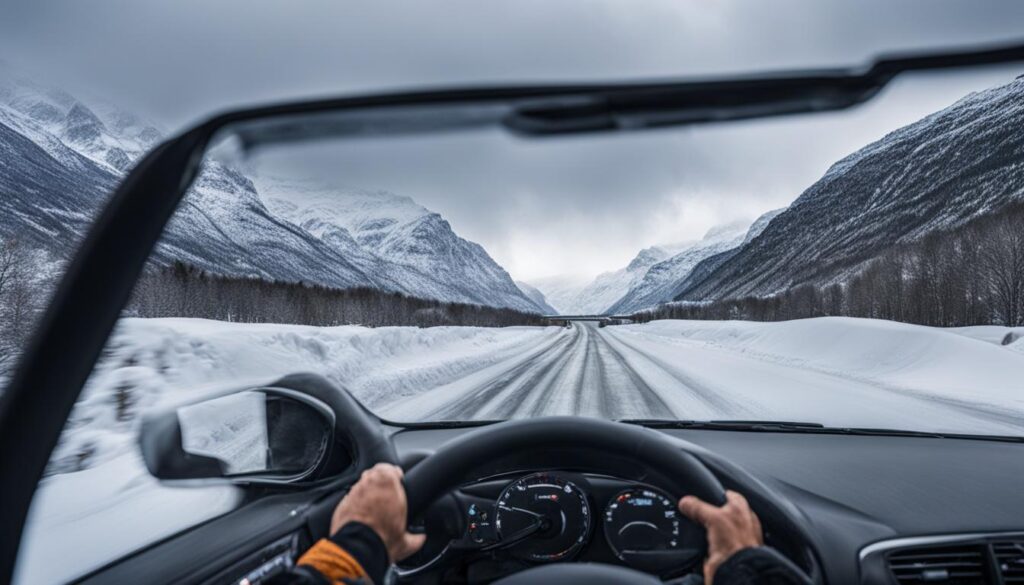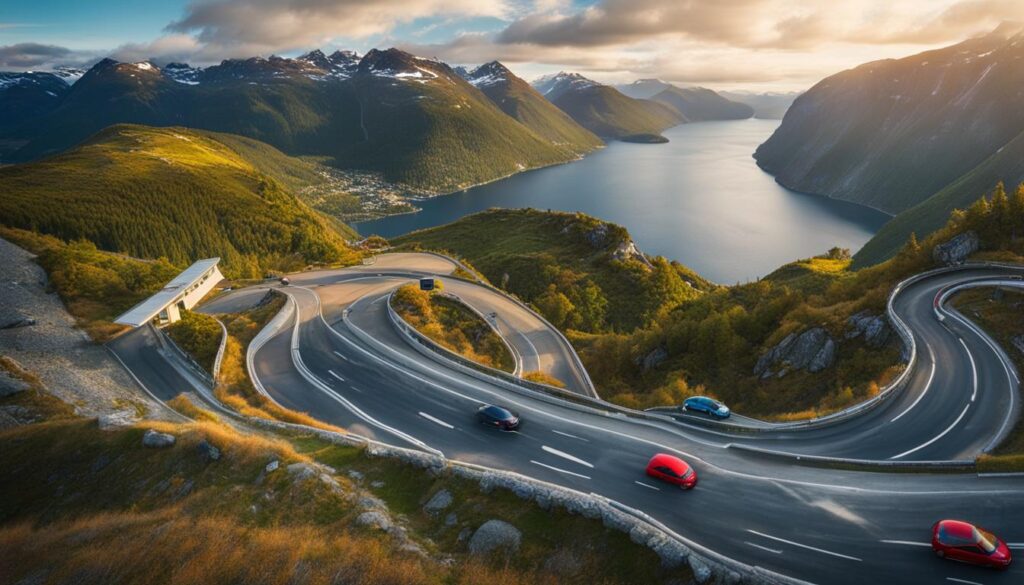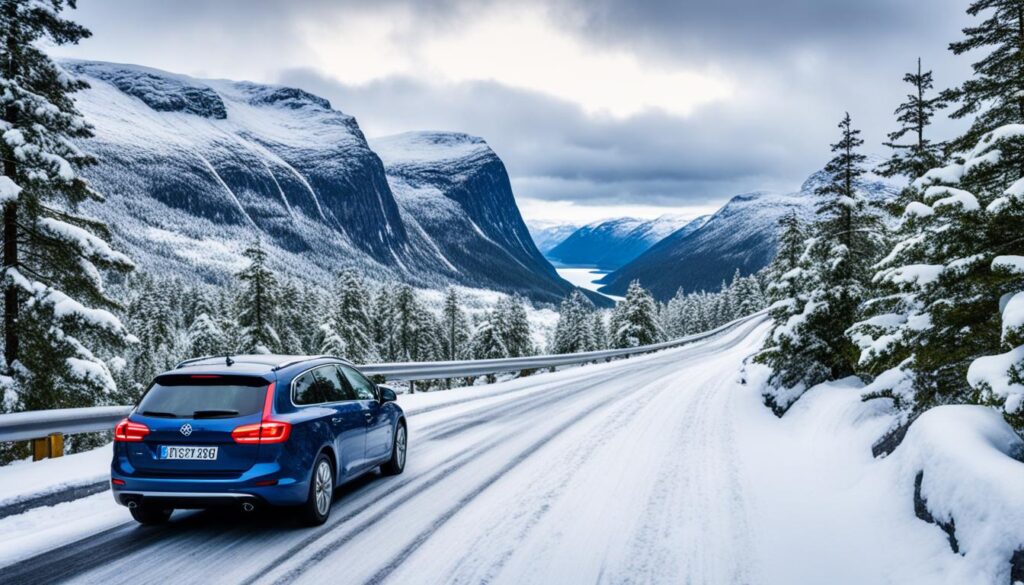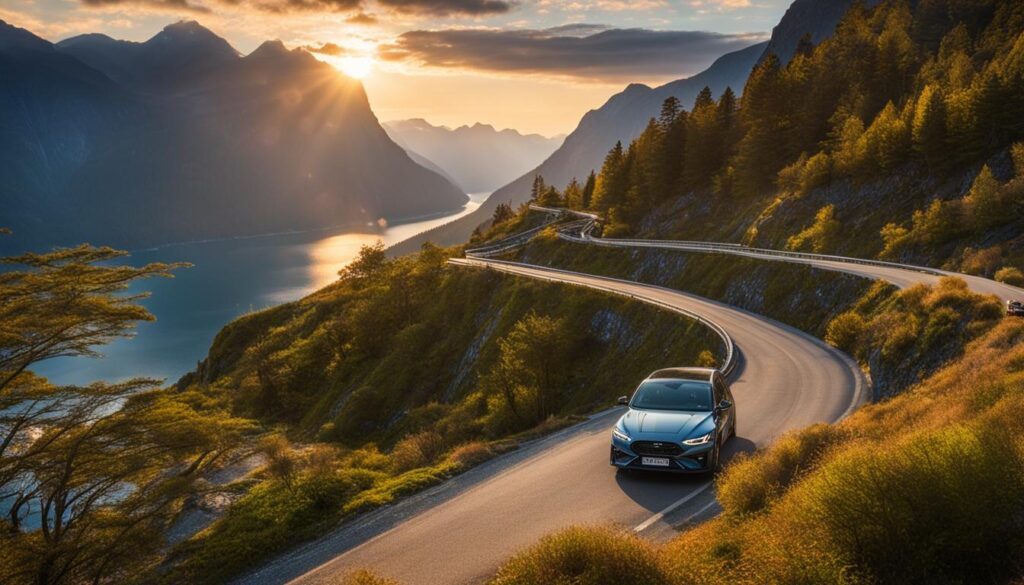If you’re planning a road trip in Norway, it’s essential to be prepared for the unique challenges that come with driving in this beautiful country. From navigating scenic routes to handling diverse weather conditions, there are various factors to consider to ensure a safe and enjoyable road trip. In this article, we’ve compiled a list of essential tips for driving in Norway, including driving safety, renting a car, and exploring scenic routes and attractions. By following these tips, you can explore Norway safely and make the most of your road trip experience.
What are some tips for driving in Norway? Keep reading to learn more about the rules of the road in Norway, obtaining a valid driver’s license, handling weather conditions, and navigating road hazards. Whether you’re a seasoned driver or a first-time visitor in Norway, these tips will help you explore the stunning landscapes of the country with confidence.
Understanding Road Rules in Norway
When driving in Norway, it is important to familiarize yourself with the rules of the road to ensure you have a safe and enjoyable trip. Keep in mind that Norway is part of Scandinavia, so some regulations may differ from neighboring countries. Here are some essential rules and regulations to remember:
Speed Limits
Speed limits in Norway vary depending on the type of road and location. In urban areas, the speed limit is usually between 30-50 kilometers per hour (18-31 miles per hour). On country roads, the limit is typically 80 kilometers per hour (50 miles per hour), while on highways, it is 90 kilometers per hour (56 miles per hour) or 100 kilometers per hour (62 miles per hour) in some cases. Be sure to keep an eye out for posted speed limit signs, as they may vary in different regions.
Right of Way
As a general rule, vehicles on the right-hand side have the right of way in Norway, although roundabouts and other intersections may have different rules. When approaching an intersection, be sure to yield to vehicles already in the intersection and give way to pedestrians and cyclists as required by law.
Traffic Signs
Norwegian road signs adhere to international standards, with red signs indicating prohibitions or danger and blue indicating mandatory actions or information. Keep an eye out for specific signs indicating narrow roads, low clearance, or steep inclines.
Driving in Scandinavia
If you plan on driving to neighboring Scandinavian countries such as Denmark, Sweden, or Finland, be aware that there may be subtle differences in road rules and regulations. For example, Sweden uses daylight running lights, and Denmark requires drivers to always use dipped headlights, even during the day. Familiarize yourself with the specific laws and regulations of each country before driving there.
TIP: Prioritize the speed limit. Exceeding the speed limit can result in heavy fines, so it is essential to stay within the allowed limit. Remember that in Norway, the speed cameras are hidden, so always be alert and follow the posted signs.
Obtaining a Valid Driver’s License
If you plan on driving in Norway, ensure you have a valid driver’s license. If you have a valid driver’s license from an EU/EEA country, you can use it in Norway without any additional requirements. For other countries, an International Driving Permit (IDP) is required, in addition to your valid driver’s license.
The IDP should be obtained in your home country before arriving in Norway and will be valid for a maximum of one year. It is important to note that IDPs cannot be issued in Norway, so make sure to obtain one before your trip.
If you plan on staying in Norway for more than six months, you will have to exchange your foreign driver’s license for a Norwegian one.
In addition, it is important to note that there are certain age restrictions for driving in Norway. The minimum age to drive a car in Norway is 18 years old, while the minimum age for renting a car may vary depending on the rental company.
Renting a Car in Norway
When it comes to exploring Norway at your own pace, renting a car is a popular and convenient option. Norway offers some of the world’s most breathtaking scenic routes, and having your vehicle allows you to stop and admire the stunning natural landscapes on your road trip.
Here are some tips to guide you through the process of renting a car in Norway:
Choosing the Right Rental Company
It’s essential to choose a trusted and reputable rental company to ensure smooth and hassle-free car rental. Research online for reviews and ratings of different rental companies in Norway to find the one that suits your needs.
“Before booking a rental car, check if the company offers 24-hour support and roadside assistance to avoid any unexpected issues on your trip.”
Understanding Insurance Options
Before signing the rental car agreement, make sure you understand the insurance options offered by the rental company. In Norway, rental cars come with mandatory third-party liability insurance. However, you may opt for additional coverage to protect yourself in case of an accident or theft.
Necessary Documentation
When renting a car in Norway, you’ll need to provide a valid driver’s license, passport, and a credit card in the renter’s name. If you have an international driver’s license, it’s necessary to carry it with you while driving in Norway. Additionally, your driver’s license must be in English or Norwegian, and other languages require an official translation.
Now that you know the basics of renting a car in Norway, you’re ready to hit the road and explore Norway’s natural beauty at your own pace. Keep in mind that driving in Norway requires caution, especially on the curvy and narrow roads that are abundant in the countryside. Drive safely and enjoy the stunning views!
Navigation and GPS Systems
Driving in Norway can be an exciting experience, but navigating unfamiliar roads can be challenging. Fortunately, GPS systems and navigation apps can help simplify your journey and ensure you stay on the right track. Here are some suggestions for reliable GPS systems and navigation apps to make your Norway road trip a success:
Google Maps
A popular choice for navigation, Google Maps offers detailed maps and real-time traffic updates. With its easy-to-use interface, you can easily search for destinations, find alternate routes, and save favourite locations for future reference. Plus, it works offline, making it a perfect choice to navigate the scenic yet remote areas of Norway. Just be sure to download the maps of the areas you’ll be driving through beforehand to avoid any data usage charges.
TomTom GO Navigation
This app has specific maps of Norway, which offer good coverage of even rural areas. TomTom GO Navigation provides detailed maps, real-time traffic updates, voice-guided navigation instructions, speed camera warnings, and even lane guidance, making it ideal for navigating the country’s winding roads. The app also offers offline maps, so you’ll never have to worry about losing your way.
Sygic GPS Navigation & Offline Maps
This app provides offline maps and navigation, so you can enjoy your Norway road trip without having to worry about expensive data roaming charges. With real-time traffic updates, voice-guided navigation, and lane guidance, Sygic GPS Navigation is perfect for navigating Norway’s challenging roads. The app also offers helpful features such as speed camera alerts and parking suggestions.
Next time you hit the road in Norway, make sure you have a reliable GPS system or navigation app to help guide you. With these suggestions, you’ll stay on the right track and enjoy a stress-free road trip through Norway’s stunning landscapes.
Wildlife and Road Hazards
Driving in Norway’s beautiful landscapes can be a thrilling experience. However, it’s important to be aware of potential road hazards, especially encounters with wildlife. These can include moose, reindeer, and even whales in some areas. To ensure your driving safety in Norway and prevent accidents, here are some essential tips:
- Be alert: Always be aware of your surroundings and scan the road for any potential hazards, especially at dawn or dusk when animals are most active.
- Reduce speed: Slow down when driving in areas with wildlife signs or commonly known as wildlife areas to have better reaction time in case an animal suddenly appears.
- Do not honk: Avoid honking as it can startle the animals and cause them to behave unpredictably.
- Use high beams: Switch to high beams when possible to improve visibility, especially in poorly lit areas.
- Prepare for emergencies: Keep a first aid kit and emergency equipment, such as flares and reflective triangles in your car.
In addition to these tips, it’s essential to be prepared for other potential road hazards, such as sharp turns, narrow bridges, and steep inclines. Always obey traffic signs and posted speed limits for a safe and enjoyable driving experience.
Handling Weather Conditions
When driving in Norway, you’ll encounter diverse weather conditions. Being prepared for these weather changes is crucial to ensure your safety on the road. Here are some weather-related tips to keep in mind during your drive:
- Always check the weather forecast before embarking on a trip.
- In case of rain, reduce your speed and maintain a safe distance from other vehicles.
- In snowy conditions, use winter tires and install tire chains when necessary.
- In foggy weather, slow down and use your headlights or fog lights to improve visibility.
- In extreme weather conditions, such as storms or heavy snowfall, stay off the roads until conditions improve.
Remember, driving in Norway requires your utmost attention and caution, especially during unpredictable weather changes.
“Weather is a great metaphor for life — sometimes it’s good, sometimes it’s bad, and there’s nothing much you can do about it but carry an umbrella.” -Terri Guillemets
Parking and Toll Roads
When driving in Norway, understanding local parking regulations and toll roads is essential to avoid fines and other issues. Follow these tips to stay informed and prepared:
Finding Parking Spots
Most cities and towns in Norway have designated parking zones with specific regulations. Look for signs or painted markings on the ground to determine the rules for the area. Some areas may require payment through a parking meter or app, while others have free parking for a limited time period.
When parking, ensure that your car is not obstructing traffic or pedestrian pathways. Avoid parking in areas marked for emergency vehicles or disabled individuals. Be aware that many parking areas may have time restrictions or fees depending on the time of day or day of the week, so always check for signage.
Toll Roads
Norway has an extensive network of toll roads, especially in the major cities and on intercity highways. When entering a toll road, there are various methods to pay, including cash, card, and automatic toll tags. Make sure to research the options and have the necessary funds ready.
Some toll roads have an automatic system that charges your rental car company or registered vehicle owner, while others require manual payment through a toll booth. If you do not pay the toll fee, expect to receive a fine in the mail.
“Make sure to read the signs and understand local parking regulations to avoid fines.”
Safety Equipment and Emergency Preparedness
Ensuring your safety and that of your passengers should be the top priority when driving in Norway. It is essential to have the necessary safety equipment in your car and know what to do in case of an emergency. Here are some tips on driving safety in Norway:
Car Essentials
Make sure you have the following safety equipment in your car:
- Reflective vest: This should be easily accessible and worn in case of an emergency.
- Warning triangle: Place this 50 meters behind your vehicle to warn other drivers in case of a breakdown.
- Spare tire: Make sure it’s in good condition and fully inflated.
- Jumper cables: In case your battery dies, jumper cables can be used to start your car.
- First aid kit: In case of an accident, a first aid kit can be a lifesaver.
- Flashlight and batteries: This can come in handy in case of a breakdown at night or in low light conditions.
What to do in Case of an Emergency?
In case of a breakdown or accident, there are a few things you need to do:
- Signal: Use your warning triangle or turn on your hazard lights to warn other drivers.
- Stay safe: Put on your reflective vest, and keep yourself and your passengers at a safe distance from the road.
- Call for help: If you have any issues with your car, call the rental company or emergency services, depending on the situation.
- Document: In case of an accident, take pictures and document any damage to your car or any other vehicles involved.
By following these tips for driving safety in Norway and being prepared for emergencies, you can ensure a safe and enjoyable road trip.
Road Etiquette and Courtesy
When driving in Norway, it’s important to understand and follow local road etiquette to ensure a smooth and safe driving experience. Here are some tips to keep in mind:
- Always use your headlights, even during the day. This helps other drivers see you, especially during the dark winter months.
- Yield to pedestrians at marked crosswalks and intersections. It’s the law in Norway and shows respect for others.
- Respect road signs and signals, even if you feel they are unnecessary. It’s better to be cautious and follow the rules.
- Be mindful of other drivers and maintain a safe distance between vehicles. Tailgating or sudden lane changes can be dangerous and cause accidents.
- Say thank you. If someone lets you merge or gives you right of way, a friendly wave or nod is appreciated.
By following these tips, you’ll not only ensure your own safety but also show consideration and courtesy to other drivers and pedestrians on the road.
Exploring Scenic Routes and Attractions
If you’re planning a road trip in Norway, you won’t be disappointed when it comes to scenic routes and attractions. Here are some of the top must-visit spots during your journey:
Norwegian Scenic Route
The Norwegian Scenic Route is a collection of 18 stunning drives throughout Norway. Each route has its own unique landscape, ranging from fjords to mountains to coastline. Some of the most popular routes include the Geiranger-Trollstigen route, which offers breathtaking views of the Geirangerfjord and the famous Trollstigen hairpin road; the Lofoten route, which takes you through picturesque fishing villages and stunning beaches; and the Hardanger route, which has beautiful waterfalls and orchards.
Preikestolen
Preikestolen, also known as Pulpit Rock, is a popular hiking spot and one of the most photographed attractions in Norway. The hike to the top takes around two hours, but the panoramic view of the Lysefjord from the top is worth it.
Nordkapp
Nordkapp, or the North Cape, is the northernmost point of Europe. The drive to the cape takes you through scenic landscapes and small fishing villages. Once you reach Nordkapp, you can enjoy stunning views of the Arctic Ocean.
Bergen
Bergen is a charming city located on the west coast of Norway, surrounded by mountains and fjords. The city has picturesque streets with colorful wooden buildings, and you can take a stroll through the famous Fish Market or ride the funicular to the top of Mount Fløyen for panoramic views of the city.
There are many more attractions and scenic routes to explore in Norway, but these are just a few to get you started. Safe travels!
Conclusion
Now that you have read through these essential tips for driving in Norway, you are well-equipped for a safe and enjoyable road trip. Remember to always familiarize yourself with the road rules, obtain a valid driver’s license, and rent a car that suits your needs. Make sure you have a reliable navigation system and be prepared for different weather conditions, road hazards, and emergency situations.
By following these Norway driving tips, you can confidently explore the country’s stunning landscapes without any hassle. Don’t forget to show courtesy to other drivers and respect road signals to ensure a smooth driving experience.
Lastly, don’t miss out on Norway’s scenic routes and attractions during your road trip. Plan stops along the way to enjoy the breathtaking views and unique experiences the country has to offer.
Overall, driving in Norway can be an unforgettable adventure. By keeping these tips in mind, you can have a safe and memorable road trip in Norway.































